GOLE1, also called GOLE1 F1, is an interesting device because it’s quite difficult, it’s like the offspring of a mini PC and a tablet with a smallish phone-like 5″ capacitive touch screen. It also dual boot Windows 10 and Android 5.1. I’ve already discussed about the hardware, and taken picture of the device, accessories, and motherboard, in the first part of the review, so today I’ll report my experiences with Windows 10 and Android 5.1, as well as the potential use cases. Since I’ve already reviewed Intel Atom x5-Z8300 mini PCs, as well as a dual boot Windows and Android Intel mini PC, I’ll focus on what makes GOLE1 different in this review.
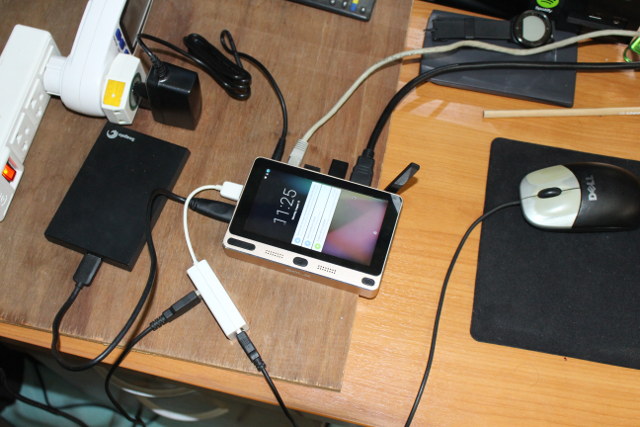
GOLE1 Dual Boot and Use Cases
I normally check my emails on my smartphone while having breakfast in the morning, but one day the charging micro USB cable was not connected properly to my phone, so I decided to try using GOLE1 has a portable device, as I had connected it a few days on my desk without actually booting it.
After pressing the power button a few couple, the device will boot and show GOLE logo with a Setup icon to access Aptio Setup Utility (UEFI / BIOS), and a couple of second later, you’ll be presented with a choice of using Android or Window, which default to the previously selected opertating system if you don’t press any keys after a 10 seconds timeout.
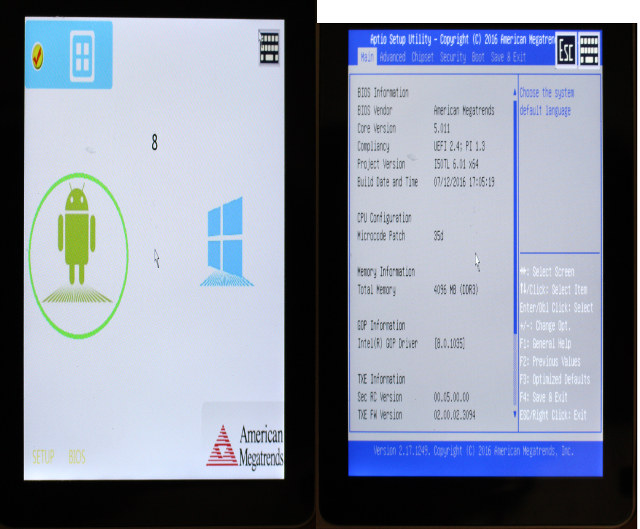
You’ll notice my pictures are in portrait mode, simply because if GOLE is placed on its back on a flat surface it will boot in portrait mode by default. If you decided to enter Aptio Setup Utility, there’s no way to rotate the display here, and there’s no HDMI output either. If you want to use the more convenient landscape mode, you’d have to boot the device by holding it in the right position….
The very first I played with it, Windows was selected by default, so I decided to go ahead to use it to check my email, however I first found the display hard to read (I have breakfast outdoors), so I had to set brightness to 100%, and it was a little better, but not quite perfect, so I’d say the screen is poor for outdoor use due to the reflections.
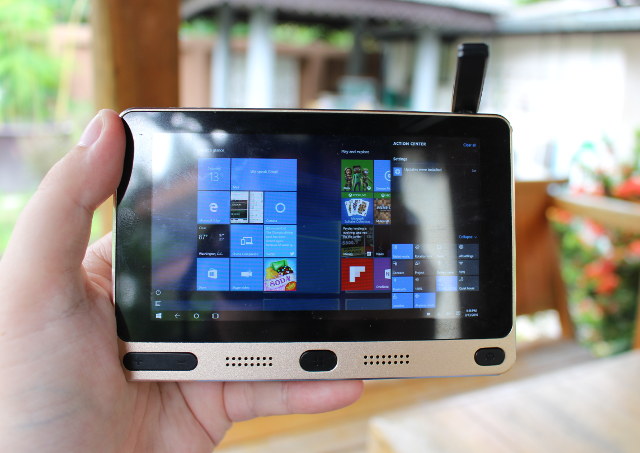
The second and even more frustrating issue that’s using Windows 10 on 5″ display amounts to torture as everything is so small, at least with the default DPI settings, as text is very hard to read, and everything is so small it’s difficult to tap with any accuracy… So after playing with it for 5 minutes, I decided to reboot, and switch to Android 5.1 instead.
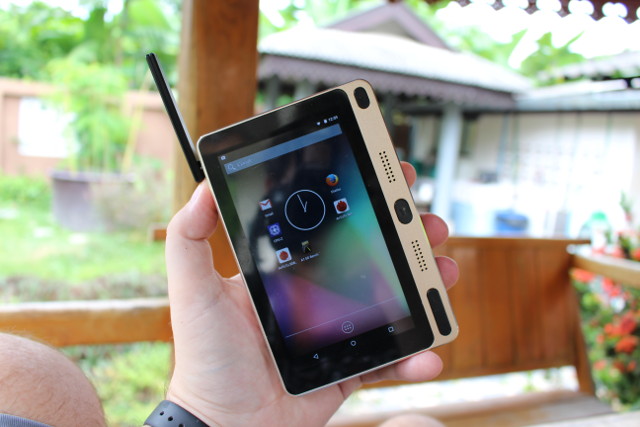
That was much more usable. The display has a 1280×720 resolution so don’t expect an amazing experience, and viewing is rather poor even at maximum brightness, but at least I could use it to check my emails with gmail, and read some news. I used it for about 30 minutes, and I have to say it’s a little heavy, so it might not be ideal over longer period of time. If I had my phone sufficiently charged with me, I would never consider using GOLE1 as a portable device.
But maybe it’s better as a mini PC with dual displays support thanks to its extra HDMI port. So I connect a whole bunch of USB devices including two RF dongles for air mouse and gamepad, a USB 3.0 harddrive to the USB 3.0 port, and a USB hub for USB keyboard and mouse, plus the usual cable for TV (HDMI), display, and power. I first placed the mini PC flat on the table, and it will show in portrait mode in both the 5″ display and TV (Please ignore the vertical lines on the television, as it is the TV’s problem).
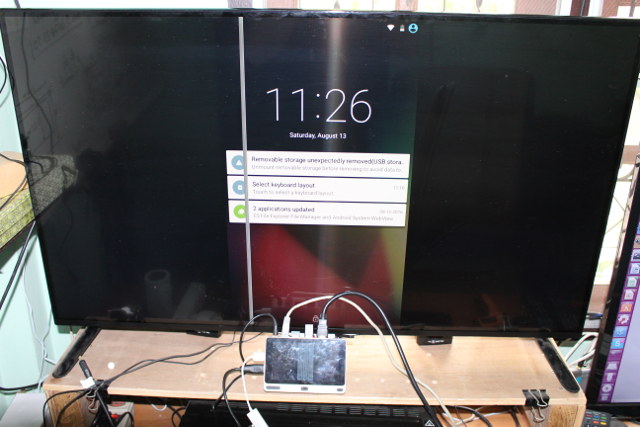
That’s just a small issue, as you can move the device around to switch to landscape mode.
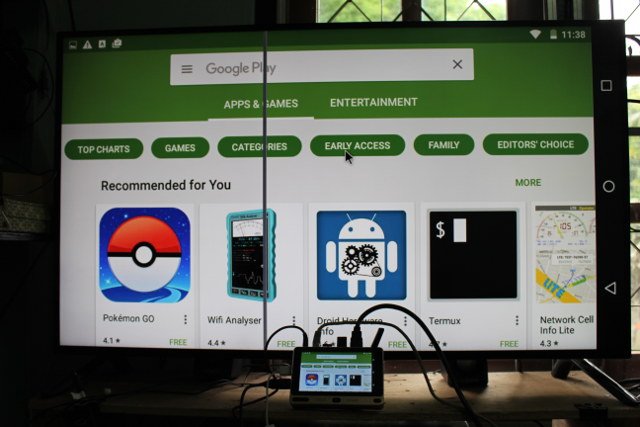
The next problem is that it will automatically enter sleep mode after a few seconds of inactivity. That’s annoying, but there a simple fix, as you can disable sleep mode in the display menu. You can also change video output up to 3840×2160 @ 30 Hz or 4096×2160 @ 24 Hz if your TV supports it.
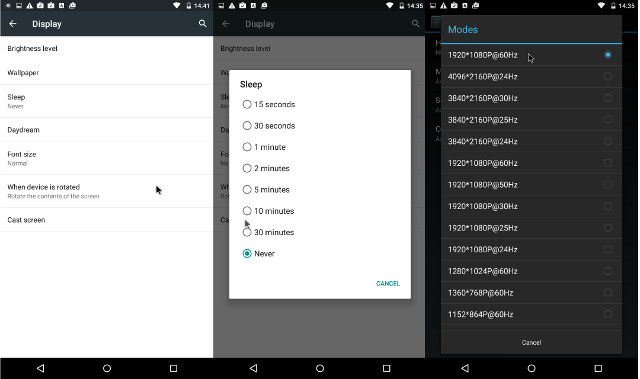
This won’t change the user interface / frame buffer resolution however, which is set to 1280×720, and with the DPI settings used (fixed in firmware), text looks quite big on the TV. There’s also no option to force landscape mode, so you’d probably have to install Set Orientation app using Googke Play to make sure the screen is in landscape mode. The unusual position of the status bar on the right while in landscape mode, and the fact that both the 5″ display and TV display would be turned on during might be an annoyance while playing videos for example. So GOLE1 can be used as an Android TV box, but I don’t find it to be doing a good job at it. Extended display, i.e. different content on either screen, is not possible in Android.
So let’s boot Windows 10 instead in the same configuration, and by default the system is using mirroring mode.
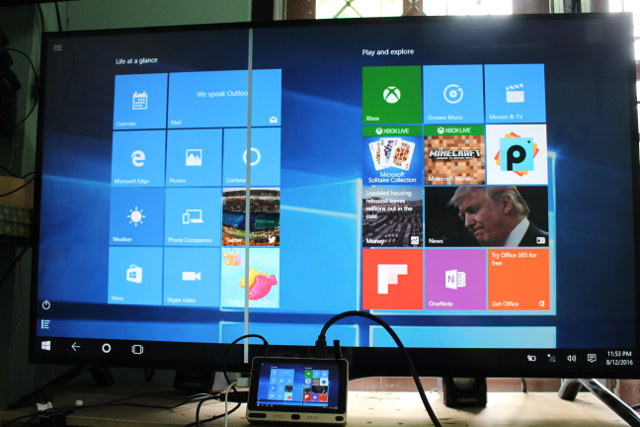
Windows 10 works fine, but by default the resolution set to 1280×720 on the TV too in that mode, so it’s not ideal. You can change it to whatever output you want however, and I did manage to change it to 1920×1080 @ 60 Hz. The text becomes completely unreadable on the small display, but it’s pretty good on the large disaply. You may want to force the orientation to landscape in Windows options so the 5″ screen don’t rotate to portrait mode.
I also tested Extended Desktop in Windows with the TV screen used as the primary display, and set to the resolution I want, e.g. 1920×1080 @ 60 Hz (up to 4K @ 30 Hz), while the 5″ display remains at 1280×720 resolution.

This works, but just like in portable mode, the text on the 5″ display is hardly readable, and when you launch an app from the TV screen, it may launch in the small display, so you may have to drag it to the big screen to use it. I think this setup is most useful in very specific applications, where the 5″ display would be used with a remote app, and the big display showing whatever the user want, something like a digital signage system with the user being able to select options from the built-in touchscreen, and info shown on the large monitor. For most people, the best option might be to select Single Display mode to turn off the 5″ display completely.
I have not tried Ubuntu, but Brad Linder of Liliputing did, and actually successfully loaded both Ubuntu 16.04 and Remix OS operating systems from a USB stick. Built-in WiFi and Audio did not work, as expected since you need to work a little harder to enable Audio and Wifi, so he used a USB audio card and an external USB Wifi dongle… Mirroring did not work, but Extended Desktop was usable.
GOLE1 Android 5.1 Info and Benchmarks
Now that we’ve gone through the different configurations / use cases made possible with GOLE1, I’ll report some more information about the operating systems themselves, starting with Android. Note that while I’m mostly used the device in landscape mode, I took the screenshots in portrait mode, because it is more convenient for the review, as text would often be split over multiple screens in landscape mode.
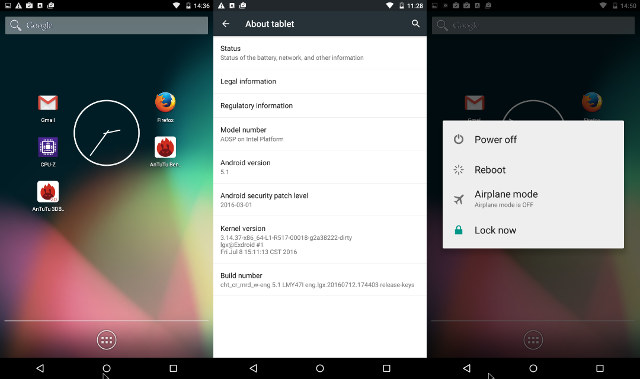
The device runs Android 5.1 on top of Linux 3.14.37. I had no trouble using Google Play, and browsing, but as mentioned previously the screen resolution and density use makes it really big on the large screen. Using it as an Android tablet was better, although the screen is small, and device heavy. I have not evaluate the battery life, because I got an early sample with a smaller battery.
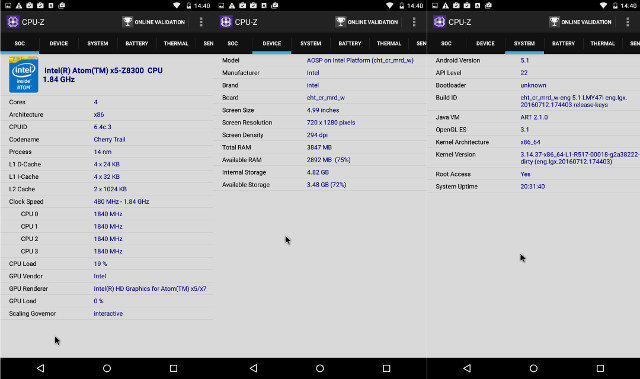
CPU-Z shows an Intel Atom x5-Z8300 quad core CPU up to 1.84 GHz with Intel HD graphics is used by the device called “AOSP on Intel Platform (cht_cr_mrd_w)”. Screen resolution is 720×1280 with 294 dpi, with 3847MB total RAM, and 4.82 GB internal storage.
GOLE1 got a decent 49,457 points in Antutu 6.0 (in landscape mode), but remember that the 1280×720 resolution will have posively affected the 3D graphics results compared to platforms running at a more common 1920×1080 resolution.
The 64GB flash was expected to be faster than most 8/16GB flash used in TV boxes, and the results obtained with A1SD bench are indeed pretty good with 58.82 MB/s sequential read speed, and 46.03 MB/s write speed.
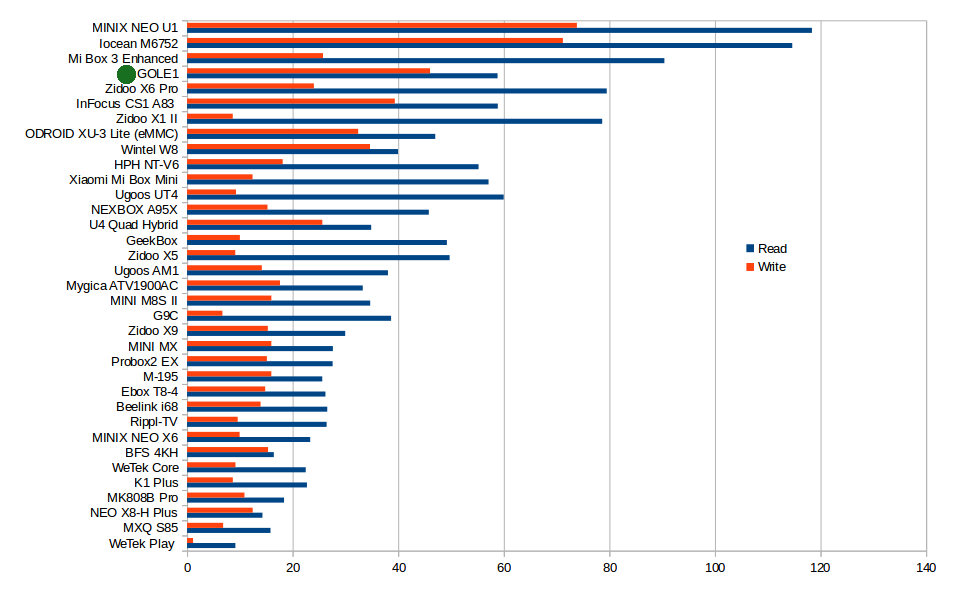
Normally, I’d also measure USB hard drive performance here, but none of my USB HDD partitions would show in Android.
I could use the Fast Ethernet connection without issues in Android, but WiFi performance varies much more between device, so that’s what I measured it connected to my 2.4GHz router. The device could also find my 5 GHz access point (802.11n only, no 802.11ac). WiFi throughput is tested by transferring a 278MB file over SAMBA back and forth using ES File Explorer. Download speed was acceptable at around 2.2 MB/s, but I got some stalling issue during one upload, and generally was slower, around 1.5 MB/s when no connection loss. The average was still a rather weak 1.8 MB/s.
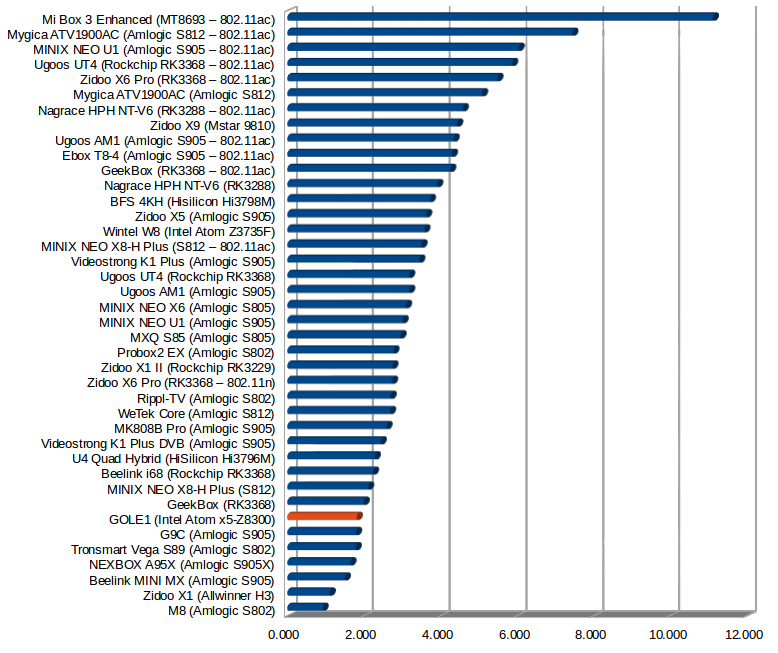
GOLE1 Windows Info and Benchmarks
Windows 10 desktop in GOLE1 is completely standard, apart that the resolution is 1280×720 on your monitor or TV by default.
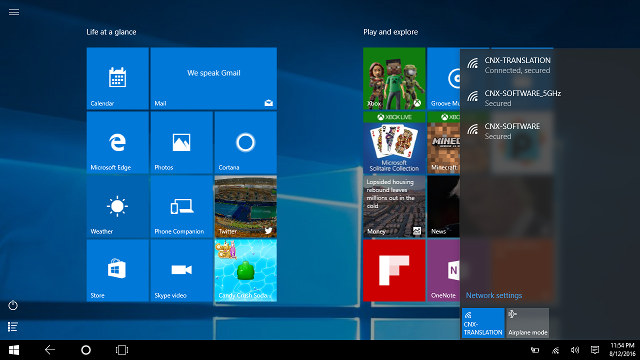
One of the reason of adding an often useless 5″ display to a mini PC is to get it into the “tablet with small screen” category with Microsoft, so that you can install Windows 10 with a free license… So that’s no surprise Windows 10 Home 64-bit is activated in the device, although I though it was not valid for 4GB. If Microsoft was not such an obscure company people could check themselves whether the license is right, but AFAIK the license conditions are not published publicly.
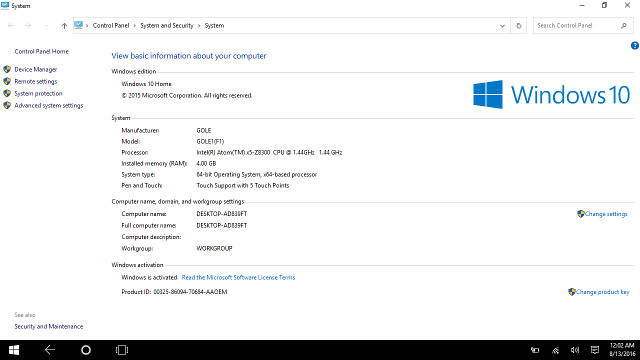
The system info windows also shows the model is GOLE1 (F1) powered by Intel Atom x5-Z8300 processor @ 1.44 GHz with 4GB RAM.
My USB hard drive connected to the USB 3.0 is still not detected in Windows 10, and I can only see the 49.6 GB partition. There’s 33.8 GB free, but I took the screenshot at the end of the review.
 While storage performance was very good for an Android TV box, Windows based mini PCs often achieve well over 100MB/s (up to 400 MB/s) sequential read and write speeds, and relatively fast random I/Os, which is not really the case here.
While storage performance was very good for an Android TV box, Windows based mini PCs often achieve well over 100MB/s (up to 400 MB/s) sequential read and write speeds, and relatively fast random I/Os, which is not really the case here.
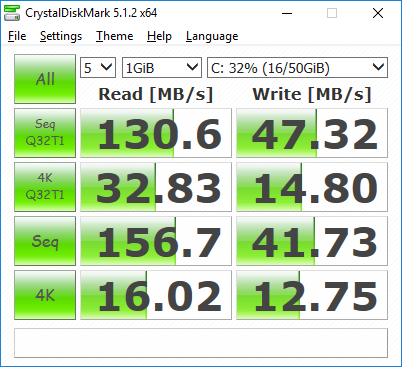 HWiNFO64 reported information is pretty standard.
HWiNFO64 reported information is pretty standard.
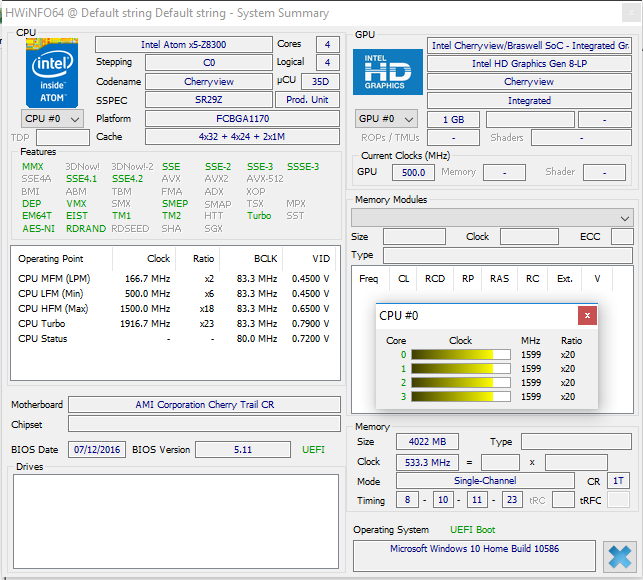 At first, I decided to skip Windows 10 benchmarks, because Intel Atom x5 processors performance is well known, so I only ran AIDA64 Extreme System Stability Test for 10 minutes, while monitoring thermal throttling stage, CPU cores frequency and temperature with HWiNFO64.
At first, I decided to skip Windows 10 benchmarks, because Intel Atom x5 processors performance is well known, so I only ran AIDA64 Extreme System Stability Test for 10 minutes, while monitoring thermal throttling stage, CPU cores frequency and temperature with HWiNFO64.
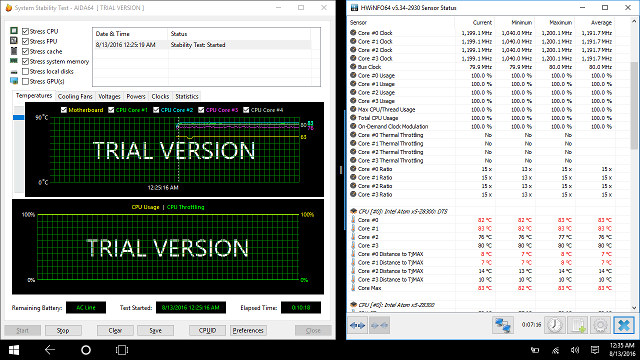
The CPU temperature was rather high for all 4 cores at over 80 C, but HWiNFO did not report any throttling. However, when checking the maximum CPU frequencies, it’s obvious something is very wrong, because it never went over 1,200 MHz, while Intel Atom x5-Z8300 processor base frequency is 1.44 GHz, and turbo frequency is 1.84 GHz.
So I changed my mind about benchmark, and after letting the system cool down for a while, I installed and ran PCMark 8 HOME ACCELERATED 3.0 benchmark.

GOLE1 got 1,254 points, which compares to 1,354 points on Atom x5-Z8300 based Tronsmart Ara X5, so about 7% slower which could be caused by the slower eMMC flash or some throttling, although the processor did not overheat, and frequency got up to 1.84 GHz during the benchmark.
I left GOLE1 connected to the mains all day during Windows 10 testing, and strangely, I could see the system reporting the battery was “Not Charging”.
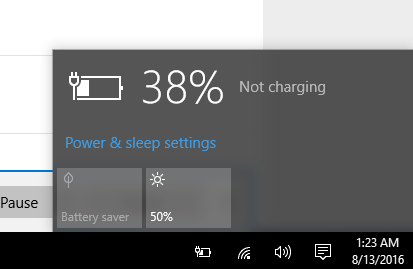 However, I also checked later, and the battery level went up to 40% still not charging, and latter down to 33%. So it looks like the system will not always charge to battery while Windows 10 is running, and you have to turn the mini PC off to charge it.
However, I also checked later, and the battery level went up to 40% still not charging, and latter down to 33%. So it looks like the system will not always charge to battery while Windows 10 is running, and you have to turn the mini PC off to charge it.
Conclusion
In theory, GOLE1 is an awesome little device which can be your Windows or Android tablet, Android TV box, or Windows 10 mini PC, as you see fit. But in practice, Windows 10 is really hard to use on a 5″ screen, Android works better, but the screen is high reflective making it poorly suited to outdoor use, when you connect the device to your TV with Android, the resolution is limited to 720p, and you have to hack your way out to make it usable. In Windows 10, it’s a little better when using a TV in either Single Display, Mirroring, or Extended Display mode. The 5″ screen is still unreadable in most modes, so Single Display might be the best option. GOLE1 can do many things, but none of them very well. It might be useful in some specific applications, where you may want a touch screen display with a control app, to let the user access info or play videos on the large screen, or simply use it as a control panel for some machines without external display.
PROS
- Innovative design combining tablet and mini PC
- Dual boot of Windows 10 Home (activated) and Android 5.1
- Affordable price
CONS
- Windows 10 is close to unusable on a 5″ screen with the default resolution 1280×720 and DPI settings.
- 5″ screen has poor visibility outdoors even with maximum brightness
- GOLE1 is a rather heavy as a portable device
- Poor WiFi performance, and unreliable at times
- My USB 3.0 hard drive was no recognized in either Android or Windows (power supply issue?)
- The system appears to default to Portrait mode when placed on a flat surface
- Battery does not appear to be charging continuously in Windows 10
- Minor – Android set to sleep very fast (a few seconds) by default, which is a real annoyance when connected to TV (Settings changes fix this)
- GOLE1 is throttling under heavy load after a couple of minutes.
“Jack of all trades, master of none” is probably appropriate for GOLE1 F1. I’d still like to thank GOLE for giving me the opportunity to review GOLE1. You can purchase the device for $99 with 2GB RAM/32GB flash, and $154.99 with 4GB/64GB (as reviewed here) on GearBest (GBGF4 or TENOFF coupons may lower the price further). You’ll also find both models sold as “GOLE F1” on Banggood.

Jean-Luc started CNX Software in 2010 as a part-time endeavor, before quitting his job as a software engineering manager, and starting to write daily news, and reviews full time later in 2011.
Support CNX Software! Donate via cryptocurrencies, become a Patron on Patreon, or purchase goods on Amazon or Aliexpress






So in other words this device is not very usefull…
I wanted to buy it but this test helps to not do it 🙂
It’s weird that you couldn’t get 1080p to work in mirror mode for Windows 10. It seemed to work for me, although text obviously looked incredibly tiny on the Gole1’s screen in that mode, since it was using a virtual resolution.
I don’t have the system anymore so I can’t confirm, but I might have set the external monitor as my “main” display to do that.
@Brad Linder
OK. I can switch now. I must have missed the option. I can see you can also turn off the small display by using “Single Display” mode.
@cnxsoft
Yeah, it makes a big difference in usability. Essentially I spent most of my time with the Gole1 treating it like a standard Windows 10 mini PC… but one that could also be used like a weird Android tablet or multi-screen device.
It’s not really a good shape/size for an Android handheld, and the screen’s too small to be really useful as a second display. But it’s priced competitively with other Windows mini PCs, which makes it kind of neat that it has bonus features, even if they’re not very useful.
One person on G+ asked me about the speakers. I tested them with a YouTube video in Android, and the audio quality is quite poor.
Dual os tablets are better options.
8″, mini,hdmi out,usb-c……
Gole1 Plus is coming soon – bigger display, Z8350, 5000mAh battery
https://www.minipcdb.com/articles/Meet-Gole1-Plus
Is it possible to install a linux distribution instead of the win10?
@Becks
Not sure. You can try one of Linuxium images on a USB flash drive to try it out.
Ok
So I think it is support booting from a USB stick. True?
@Becks
Yes. You can insert a bootable USB drive. Press F7 at boot time to select it.
Nice !
I’m going to order GOLE1 as per my needs instead of GOLE1 plus.